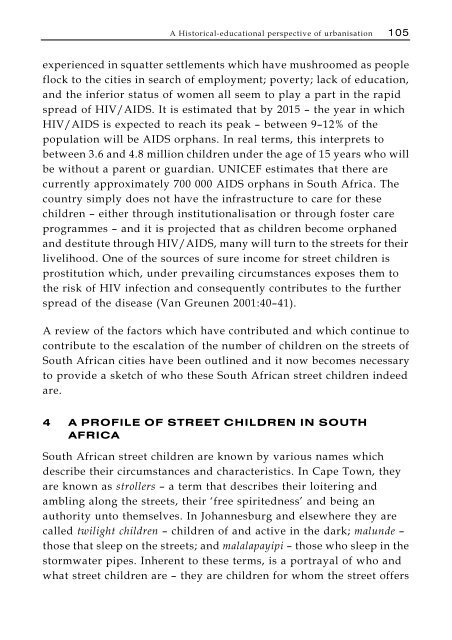- Page 1 and 2:
EDUCARE Journal of the Faculty of E
- Page 3 and 4:
(iv) 208 The Swiss missionaries' ed
- Page 5 and 6:
(vi) disciplinary frame of referenc
- Page 7 and 8:
2 has advocated an educational disc
- Page 9 and 10:
4 transform the manner of teaching
- Page 11 and 12:
6 4.1 Critical thinking This mode o
- Page 13 and 14:
8 . The classroom community of phil
- Page 15 and 16:
10 . ethical inquiry: engaging chil
- Page 17 and 18:
12 the world from the other's point
- Page 19 and 20:
14 The globalisation debate and imp
- Page 21 and 22:
16 with insights emanating from dif
- Page 23 and 24:
18 it is argued, only reflect a lim
- Page 25 and 26:
20 globalists take issue with this
- Page 27 and 28:
22 cultural factors and the reconfi
- Page 29 and 30:
24 indispensable to the contemporar
- Page 31 and 32:
26 government laboratories and corp
- Page 33 and 34:
28 dissemination. Information techn
- Page 35 and 36:
30 as a tool of destablisation, but
- Page 37 and 38:
32 Scott, P (ed) 2000. Introduction
- Page 39 and 40:
34 Pedagogics'' in 1894 in which hi
- Page 41 and 42:
36 2 THE PRINCIPLES OF THE PROGRESS
- Page 43 and 44:
38 greater growth and more lasting
- Page 45 and 46:
40 These schools were not only chil
- Page 47 and 48:
42 increasingly complex society, th
- Page 49 and 50:
44 system. An education mission was
- Page 51 and 52:
46 Textbooks and other tools of lea
- Page 53 and 54:
48 BIBLIOGRAPHY Bestor, A E 1953. E
- Page 55 and 56:
50 Let's revisit competence-based t
- Page 57 and 58:
52 2 THE FOUNDATIONS OF COMPETENCE-
- Page 59 and 60: 54 FIGURE 1 Profiling an educator's
- Page 61 and 62: 56 be expressed as outcomes, be tra
- Page 63 and 64: 58 to assume that a specific compet
- Page 65 and 66: 60 broader cognitive skills or abil
- Page 67 and 68: 62 reasonably and reliably collect
- Page 69 and 70: 64 education practitioners. Not onl
- Page 71 and 72: 66 supports Outcomes-based Educatio
- Page 73 and 74: 68 oped to manage assessment (Whitt
- Page 75 and 76: 70 Fennell, E (Ed). 1991. Developme
- Page 77 and 78: 72 University of Pretoria & Nationa
- Page 79 and 80: 74 for the principle of inclusion a
- Page 81 and 82: 76 Traditional education approach N
- Page 83 and 84: 78 not display any depth of underst
- Page 85 and 86: 80 Curriculum 21 Curriculum 2005 IN
- Page 87 and 88: 82 3 COMPARATIVE PRINCIPLES AND PRA
- Page 89 and 90: 84 learning outcomes. The object of
- Page 91 and 92: 86 strategies, including project wo
- Page 93 and 94: 88 on the lack of strong content in
- Page 95 and 96: 90 The author is in agreement with
- Page 97 and 98: 92 BIBLIOGRAPHY Burke, J (ed) 1995.
- Page 99 and 100: 94 A Historical-educational perspec
- Page 101 and 102: 96 It is the purpose of this articl
- Page 103 and 104: 98 Transvaal. Other sectors of the
- Page 105 and 106: 100 homeland towns thereby redirect
- Page 107 and 108: 102 these taxes had to be paid in c
- Page 109: 104 tend to be products of poverty
- Page 113 and 114: 108 neglect (Le Roux 2001). It is a
- Page 115 and 116: 110 . street children focus on the
- Page 117 and 118: 112 be treated as active and resili
- Page 119 and 120: 114 Van Greunen, A. 2001. Wie gaan
- Page 121 and 122: 116 generation of evidence: the fam
- Page 123 and 124: 118 mobilisation plan for education
- Page 125 and 126: 120 through content analysis, which
- Page 127 and 128: 122 defended the view of secondary
- Page 129 and 130: 124 4.6 Educators seem satisfied wi
- Page 131 and 132: 126 enough on their hands anyway.''
- Page 133 and 134: 128 5 PREPARING EDUCATORS FOR SCHOO
- Page 135 and 136: 130 in helping the school, both wit
- Page 137 and 138: 132 collaboratively. In other words
- Page 139 and 140: 134 second category of inputs comes
- Page 141 and 142: 136 Framework for training Family i
- Page 143 and 144: 138 Bastiani, J & Wolfendale, S 199
- Page 145 and 146: 140 Recognition of prior learning
- Page 147 and 148: 142 1998; Universities and Colleges
- Page 149 and 150: 144 identifying learning by means o
- Page 151 and 152: 146 whilethisconceptisknowninAustra
- Page 153 and 154: 148 together proof of his/her knowl
- Page 155 and 156: 150 . Making no distinction between
- Page 157 and 158: 152 been awarded. This can partiall
- Page 159 and 160: 154 k SKILLS/COMPETENCY DEVELOPMENT
- Page 161 and 162:
156 6.4 The necessity of quality co
- Page 163 and 164:
158 In order to ensure sound practi
- Page 165 and 166:
160 in the development of advertisi
- Page 167 and 168:
162 Since there are risks involved
- Page 169 and 170:
164 Toop, L & Burleigh, J 1993. Arr
- Page 171 and 172:
166 10% is verklaar deur Breinvoork
- Page 173 and 174:
168 Twee probleme kom na vore wanne
- Page 175 and 176:
170 intelligensie en akademiese pre
- Page 177 and 178:
172 Salili (1995:106±109) wat die
- Page 179 and 180:
174 5 DIE NAVORSINGSONTWERP VAN DIE
- Page 181 and 182:
176 Met die afneem van die toets wo
- Page 183 and 184:
178 TABEL 1 Die verband tussen die
- Page 185 and 186:
180 7 GEVOLGTREKKING EN AANBEVELING
- Page 187 and 188:
182 differently, to help him to dev
- Page 189 and 190:
184 Horn, C; Bruning, R, ea 1993. P
- Page 191 and 192:
186 1 INLEIDING EN PROBLEEMSTELLING
- Page 193 and 194:
188 optimaal te motiveer, of hoe om
- Page 195 and 196:
190 Die gevolge van 'n sportonderwy
- Page 197 and 198:
192 4 SELEKSIE VAN DIE PROEFPERSONE
- Page 199 and 200:
194 TABEL 4 Lokaliteit van sportafr
- Page 201 and 202:
196 Volgens tabel 7 het die meeste
- Page 203 and 204:
198 Volgens tabel 9 reken vakonderw
- Page 205 and 206:
200 Ten slotte is ondersoek ingeste
- Page 207 and 208:
202 6.9 Samevatting van die vakonde
- Page 209 and 210:
204 TABEL 11 Aspekte van sportsielk
- Page 211 and 212:
206 SUMMARY Sport psychology is bec
- Page 213 and 214:
208 The Swiss missionaries' educati
- Page 215 and 216:
210 2 THE GENESIS OF THE SWISS MISS
- Page 217 and 218:
212 the fray in support of the riva
- Page 219 and 220:
214 Truly formal education among th
- Page 221 and 222:
216 increase in the number of Chris
- Page 223 and 224:
218 8 THE IMPLANTATION OF FORMAL ED
- Page 225 and 226:
220 studies to include the nursing
- Page 227 and 228:
222 hunting dog by the colonisers''
- Page 229 and 230:
224 Firstly, the education system d
- Page 231 and 232:
226 their activities in this countr
- Page 233 and 234:
228 Mabunda, D C 1995. A historico-
- Page 235 and 236:
230 guidance and negative or the ab
- Page 237 and 238:
232 life (Smit in Schurick 1993:124
- Page 239 and 240:
234 highly probable that learners w
- Page 241 and 242:
236 Ð These abilities can be devel
- Page 243 and 244:
238 Ð Ð Applying criteria as the
- Page 245 and 246:
240 plays, video recordings of the
- Page 247 and 248:
242 Open-ended questions that were
- Page 249 and 250:
244 grandmother in a two-roomed hut
- Page 251 and 252:
246 Group B showed more positive fe
- Page 253 and 254:
248 Maag, J W & Webber, J. 1997. Co
- Page 255 and 256:
250 and Crime Prevention's World Dr
- Page 257 and 258:
252 point of view, Papalia and Olds
- Page 259 and 260:
254 discovering one's own identity
- Page 261 and 262:
256 Some of the street names for Ec
- Page 263 and 264:
258 potential cardiac and neurologi
- Page 265 and 266:
260 and is characterised by severe
- Page 267 and 268:
262 which the researcher selects to
- Page 269 and 270:
264 . Thephysicaleffectsoftheuseofc
- Page 271 and 272:
266 abused alcohol and often became
- Page 273 and 274:
268 The respondents all reported th
- Page 275 and 276:
270 BIBLIOGRAPHY Ausubel, D P, Mont
- Page 277 and 278:
272 The issue of perception: some e
- Page 279 and 280:
274 However, what has come to light
- Page 281 and 282:
276 4.1 Senses As the definition of
- Page 283 and 284:
278 In this frame of reference proc
- Page 285 and 286:
280 5.1 Stereotypes Stereotyping is
- Page 287 and 288:
282 7 EXAMPLES OF EDUCATIONAL PERCE
- Page 289 and 290:
284 Many definitions of democracy t
- Page 291 and 292:
286 . Although cultural factors pla
- Page 293 and 294:
288 Retief, F P 1994. Die demokrati
- Page 295 and 296:
290 2 WHAT KIND OF EDUCATIONAL CHAN
- Page 297 and 298:
292 as someone who not only has the
- Page 299 and 300:
294 c control which consists of con
- Page 301 and 302:
296 power and possibilities which r
- Page 303 and 304:
298 is now ready to be elaborated i
- Page 305 and 306:
300 ... try to ensure that everyone
- Page 307 and 308:
302 achieve success in the requirem
- Page 309 and 310:
304 7 CONCLUSION Educational change
- Page 311 and 312:
306 The Internet as an important in
- Page 313 and 314:
308 world today regarding communica
- Page 315 and 316:
310 can lead to a form of subversiv
- Page 317 and 318:
312 Students learn on the Internet
- Page 319 and 320:
314 South African teachers with com
- Page 321 and 322:
316 with music and speech detection
- Page 323 and 324:
318 learning system, and visualisat
- Page 325 and 326:
320 By eliminating inefficiencies a
- Page 327 and 328:
322 that big companies (such as Mic
- Page 329 and 330:
324 BIBLIOGRAPHY Alink, H. ``Painti
- Page 331 and 332:
326 Professional portfolio building
- Page 333 and 334:
328 Ð Ð Ð Ð Ð Reflective learn
- Page 335 and 336:
330 Ð Communicate effectively usin
- Page 337 and 338:
332 Ð Ð It helps individuals to b
- Page 339 and 340:
334 mulated. Relevant learning and
- Page 341 and 342:
336 FIGURE 2 Multiple method triang
- Page 343 and 344:
338 Phase 5: Evaluation Evaluation
- Page 345 and 346:
340 TABLE 2 Reflection on own learn
- Page 347 and 348:
342 FIGURE 3 Expectations of learne
- Page 349 and 350:
344 Lustig, K 1996. Portfolio asses
- Page 351 and 352:
346 Ð Learning styles/whole brain
















